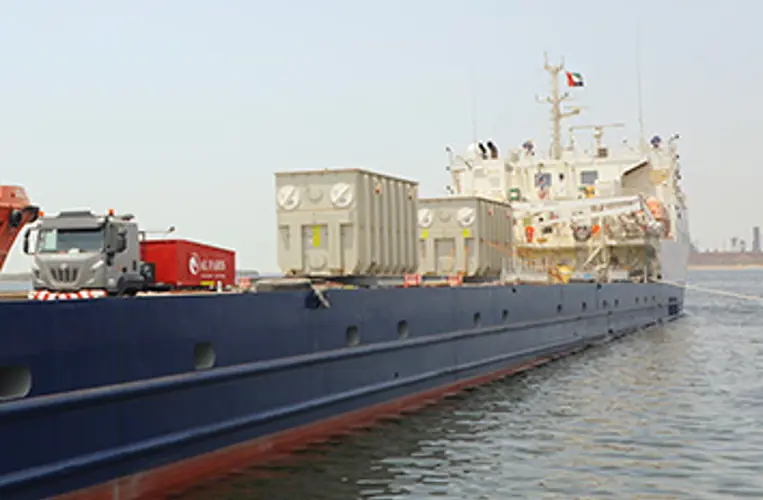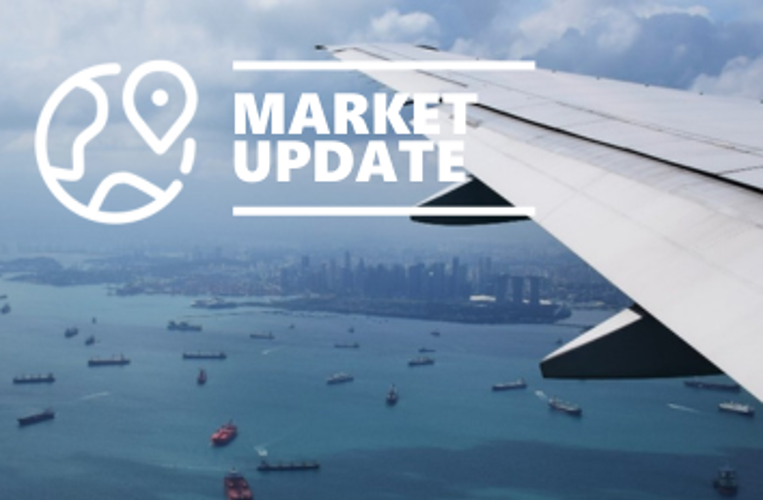On behalf of Scan Global Logistics

Global COO & CCO
Advisory
24 Jun, 2024

By now, it is clear that what some had hoped to be a short-lived crisis is here to stay for a prolonged period, and as we know all too well by now, the potential domino effects triggered by the current chaos will have a longer-lasting effect.
It is also clear that the current chaos is caused by a multitude of factors and not merely one single impact. It is a perfect storm with ingredients such as the Red Sea bypass, higher-than-expected consumer spending, early peak season, and inventory restocking.
Ocean freight rate levels remain elevated bringing back painful memories of COVID-19 rate levels to shippers across most key trade-lanes. As we speak, the most realistic scenario is that the current challenges will continue until golden week in early October.
Airfreight turns red hot again
While the ocean freight market disruption took the headlines in our last market advisory from June 7, recent weeks have also shown that the airfreight market is back to red hot. This is reminiscent of the situation in February and March with the chase for guaranteed capacity turning into a full-blown sprint for all players in the market.
In an article on The Loadstar on 19 June, Pierre van der Stichele, VP of Cargo at Charter Broker Air Partner, laid out the situation in a crystal-clear fashion: “In Q4 this year, widebody and long-range aircraft capacity will be very hard, if not impossible to find”.[1]
The new breed e-commerce giants such as Shein and Temu are undoubtedly one part of the explanation, having reserved fixed capacity for the full duration of the second half of 2024.
Richard Forson, CEO Cargolux echoed this sentiment by stating: “We’ve had requests to lock in capacity for Q4” and adding “we are operating a significant number of charters for e-commerce purposes”.
Rounding off his view on the current situation, Pierre van der Stichele bluntly stated, “I’ve never seen the industry so volatile in my near 30 years in cargo,” concluding that; “the influx of e-commerce traffic in the airfreight market had disrupted the normal seasonality and, therefore predictability of demand. [2]
Adding the ocean freight “Red Sea effect” to the systemic impact from surging e-commerce volumes, leaves us with the very clear conclusion that the rest of 2024 will be very challenging and bumpy.
CNBC quoted numbers from the Freight Intelligence platform Xeneta to illustrate the current situation.
Global air cargo demand, supply, load factor and freight rates
Year-over-year percent changes May 2023–May 2024

Source: Graph from Xeneta republished by CNBN
Niall van de Wouw, Xeneta Chief Airfreight Officer, went on to provide an insightful perspective to CNBC: “Given that 98 % of the world’s cargo is moved by ocean, even a percentage shift of 0.2 % would see a 10 % increase in airfreight volumes.[3] with this illustrating how sensitive airfreight supply and demand is relative to ocean freight disruption(s).
As always, we wish to stress the necessity of early and reliable forecasting, allowing us to plan ahead, and not least, offer alternative solutions. We are specifically seeing a significant increase in both sea-air and land-air solutions, and we are accelerating our efforts to ensure we are as best prepared for a hot airfreight market in the coming months.
No outlook for resolution of the Red Sea crisis amidst new attacks by Houthi militia
With shippers across the globe eyeing a resolution for the crisis in the Red Sea, day 191 offered little optimism to support these hopes. Attacks by the Houthis on commercial vessels in the Red Sea comtinued, thankfully, with only little damage and no casualties as a result.
The Houthis have even reported an attack on the US Navy by claiming to have launched a successful attack on the USS Dwight D. Eisenhower. However, this is being categorically denied by US CENTCOM.
The geopolitical development in recent weeks, and specifically ceasefire talks between Israel and Hamas, had sparked hope that this could result in the Red Sea crisis being resolved as well; however, for the time being, there is no indication that this will happen.
SCFI continues to increase to painful levels
The latest SCFI numbers released Friday, 21 June, showed that the average SCFI rate level across all trade-lanes increased by a further USD 171/40´. As a noteworthy remark, the rate level on Asia-Med is now very close to passing the “magic” USD 10.000/40´ mark, clocking in at USD 9.710/40´.

An increase of approximately USD 200-300/40´ were apparent on all major trade-lanes, including Asia-North Europe, and as well to the US East and West Coast, respectively.
The looming question is obviously whether a plateau stage has been reached, or if we in fact could see rate levels (again) in the range of USD 15.000-20.000/40´ as seen during the pandemic.
Recently, Sea-Intelligence issued a note forecasting that Asia-Europe spot prices could exceed USD 20.000 on account of the Red Sea crisis, with Sea-Intelligence CEO Alan Murphy commenting that: “Spot rates will continue to rise as long as there are enough shippers willing to pay the price”. He continued: “the pandemic set a precedent, which is that during times of severe distress, freight rates can reach these very high levels.[4]
As noted above, we do, as highlighted earlier, maintain a view that the current situation could be sustained up until Golden Week in early October. However, we also assess that freight rates have reached a near plateau level and accordingly do not see any indications of the rate levels forecasted by Sea-Intelligence.
It is important to highlight that our outlook is primarily focused on East-West trades. We see a more stable environment in terms of rate levels and capacity, on the traditional export markets out of Europe and as well on the Trans-Atlantic trade.
First signs of container shortage in key Asia origins
In addition to continued accelerating rate levels, other challenges in the form of port congestion and lack of available equipment are also emerging.
Reports in The Loadstar indicated a shortage of 40´ high-cube containers in Bangladesh, highlighting that both MSC and Hapag Lloyd are scrambling to re-position equipment from nearby ports. Ruhul Amin Sikder, Secretary General of the Bangladesh Inland Container Depots Association, said that: “Its depots had experienced carrier-wide shortages of 40´ boxes” and added: “that almost all the shipping lines serving Bangladesh had been facing an equipment shortage, which won´t end, said another official of large box line until the congestion at Singapore normalises”[5]
Singapore port congestion goes from bad to worse
An article published by The Maritime Executive zoomed in on one specific unforeseen impact of the Red Sea crisis, and consequently the utilisation of Cape of Good Hope routing. The extra demand for bunkering and transhipment at the already busy port of Singapore, coupled with the reshaping of shipping schedules, and specifically additional vessels having been assigned to the Asia-Europe trade-lane to cover for the extended transit times, has triggered a chaos like situation.

Picture from Maritime Executive article
The article outlined that delays had extended up to 7 days, with up to 450.000 TEU worth of containerised vessel capacity waiting to berth at the port at the end of May. In an attempt to improve the situation, terminal operator PSA Singapore has reactivated its older Keppel Terminal; however, for now, with no noticeable improvement. As a mitigation measure, many container carriers have begun to skip the port of Singapore altogether to avoid lengthy delays. However, this, in turn, is expected to cause further delays of cargo requiring transshipment at alternate ports.
Growing fears of strike disruptions on US East Coast
As Lars Jensen, Vespucci Maritime puts it: “There is an all pervasive sense of deja-vu in the container market currently”.[6]
In recent weeks, an increasingly harsh rhetoric between dock workers and the major terminal operators has prompted fears of what could be the next big hit on global supply chains.
In recent years, the major focus has been on US West Coast ports, but with the International Longshoremen’s Association (ILA) cancelling a scheduled meeting with the United States Maritime Alliance (USMX), the stakes have been raised considerably, as parties near the deadline of September where a new collective agreement for US East Coast is due.
It is important to note, though, that this form of rhetoric is a usual part of negotiation tactics. In reality, actual strikes are rare when looking through the history books. The more likely short-term risk are so-called “slow-downs” and work stoppages, with these being measures that are short of a full-scale strike.
ILA singles out Maersk as the primary cause of conflict
In a statement released last week, the ILA accused Maersk of leading the way in a damaging shift towards automisation that will result in the loss of many jobs in US Container ports.
ILA released a statement that noted; "most of the problems the ILA faces on the East and Gulf coasts all stem from APM Terminals and Maersk Line,” urging US President Joe Biden to support the dock workers.[7]
Presently, there are no new meetings scheduled between the parties. However, bearing in mind recent conflicts between the ILA and Terminal Operators, there is still sufficient time to find a solution and consequently avoid a strike that has the potential to cause further havoc on global supply chains.
Our short and mid-term outlook remains unchanged
We ask for your understanding in the current situation where demand is outweighing available capacity, and as always, our solutions and proposed way forward will be based on individual assessment of each situation.
At the same time, we wish to stress that we acknowledge the cost impact of the current market development and will do our utmost to limit same, while observing that we can deliver quality solutions.
We expect the current development to continue with no immediate outlook of the current pressure easing up.
AIR FREIGHT



OCEAN FREIGHT



All information provided is given to the best of our knowledge and does not represent specific guidance on actual development.
[1] https://theloadstar.com/flood-of-ecommerce-will-provoke-airfreight-peak-season-capacity-crunch/
[2] https://theloadstar.com/flood-of-ecommerce-will-provoke-airfreight-peak-season-capacity-crunch/
[3] https://www.cnbc.com/2024/06/13/fears-rise-ocean-freight-rates-may-hit-20000-with-no-relief-in-sight.html
[4] https://www.cnbc.com/2024/06/13/fears-rise-ocean-freight-rates-may-hit-20000-with-no-relief-in-sight.html
[5] https://theloadstar.com/shortage-of-40ft-containers-hampering-bangladesh-shipments/
[6] https://shippingwatch.com/carriers/Container/article17217983.ece
[7] https://shippingwatch.com/carriers/Container/article17213817.ece

On behalf of Scan Global Logistics

Global COO & CCO









